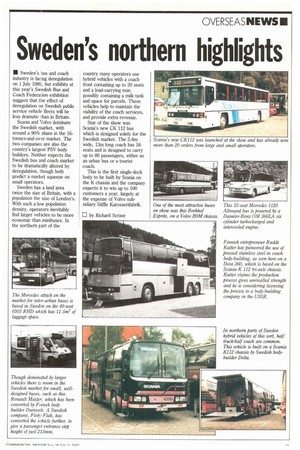Sweden's northern highlights
Page 23

If you've noticed an error in this article please click here to report it so we can fix it.
• Sweden's bus and coach industry is facing deregulation on 1 July 1989, but exhibits at this year's Swedish Bus and Coach Federaion exhibition suggest that the effect of deregulation on Swedish public service vehicle fleets will be less dramatic than in Britain.
Scania and Volvo dominate the Swedish market, with around a 90% share in the 16tonnes-and-over market. The two companies are also the country's largest PSV body builders. Neither expects the Swedish bus and coach market to be dramatically altered by deregulation, though both predict a market squeeze on small operators.
Sweden has a land area twice the size of Britain, with a population the size of London's. With such a low population density, operators inevitably find larger vehicles to be more economic than minibuses. In the northern cart of the country many operators use hybrid vehicles with a coach front containing up to 20 seats and a load-carrying rear, possibly containing a milk tank and space for parcels. These vehicles help to maintain the viability of the coach services, and provide extra revenue.
Star of the show was Scania's new CK 112 bus which is designed solely for the Swedish market. The 2.6m wide, 13m long coach has 58 seats and is designed to carry up to 80 passengers, either as an urban bus or a tourist coach.
This is the first single-deck body to be built by Scania on the K chassis and the company expects it to win up to 100 customers a year, largely at the expense of Volvo subsidiary Saffie Karosserifabrik.
0 by Richard Scrase




















































































































































